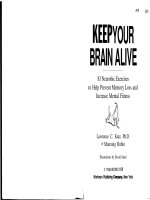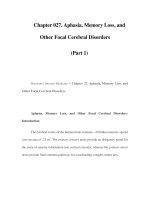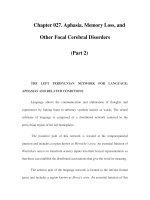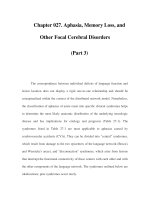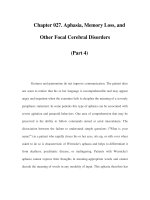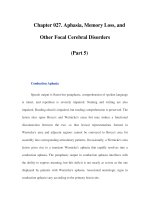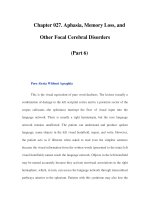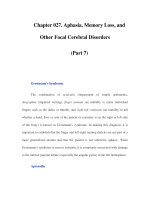Chapter 027. Aphasia, Memory Loss, and Other Focal Cerebral Disorders (Part 14) ppt
Bạn đang xem bản rút gọn của tài liệu. Xem và tải ngay bản đầy đủ của tài liệu tại đây (21.13 KB, 9 trang )
Chapter 027. Aphasia, Memory Loss, and
Other Focal Cerebral Disorders
(Part 14)
Caring for the Patient with Deficits of Higher Cerebral Function
Some of the deficits described in this chapter are so complex that they may
bewilder not only the patient and family but also the physician. It is imperative to
carry out a systematic clinical evaluation in order to characterize the nature of the
deficits and explain them in lay terms to the patient and family. Such an
explanation can allay at least some of the anxieties, address the mistaken
impression that the deficit (e.g., social disinhibition or inability to recognize
family members) is psychologically motivated, and lead to practical suggestions
for daily living activities. The consultation of a skilled neuropsychologist may aid
in the formulation of diagnosis and management. Patients with simultanagnosia,
for example, may benefit from the counterintuitive instruction to stand back when
they cannot find an item so that a greater search area falls within the immediate
field of gaze. Some patients with frontal lobe disease can be extremely irritable
and abusive to spouses and yet display all the appropriate social graces during the
visit to the medical office. In such cases, the history may be more important than
the bedside examination in charting a course of treatment.
Reactive depression is common in patients with higher cerebral dysfunction
and should be treated. These patients may be sensitive to the usual doses of
antidepressants or anxiolytics and deserve a careful titration of dosage. Brain
damage may cause a dissociation between feeling states and their expression, so
that a patient who may superficially appear jocular could still be suffering from an
underlying depression that deserves to be treated. In many cases, agitation may be
controlled with reassurance. In other cases, treatment with sedating
antidepressants may become necessary. The use of neuroleptics for the control of
agitation should be reserved for refractory cases since extrapyramidal side effects
are frequent in patients with coexisting brain damage.
Spontaneous improvement of cognitive deficits due to acute neurologic
lesions is common. It is most rapid in the first few weeks but may continue for up
to 2 years, especially in young individuals with single brain lesions. The
mechanisms for this recovery are incompletely understood. Some of the initial
deficits appear to arise from remote dysfunction (diaschisis) in parts of the brain
that are interconnected with the site of initial injury. Improvement in these patients
may reflect, at least in part, a normalization of the remote dysfunction. Other
mechanisms may involve functional reorganization in surviving neurons adjacent
to the injury or the compensatory use of homologous structures, e.g., the right
superior temporal gyrus with recovery from Wernicke's aphasia. In some patients
with large lesions involving Broca's and Wernicke's areas, only Wernicke's area
may show contralateral compensatory reorganization (or bilateral functionality),
giving rise to a situation where a lesion that should have caused a global aphasia
becomes associated with a residual Broca's aphasia. Prognosis for recovery from
aphasia is best when Wernicke's area is spared. Cognitive rehabilitation
procedures have been used in the treatment of higher cortical deficits. There are
few controlled studies, but some do show a benefit of rehabilitation in the recovery
from hemispatial neglect and aphasia. Some types of deficits may be more prone
to recovery than others. For example, patients with nonfluent aphasias are more
likely to benefit from speech therapy than patients with fluent aphasias and
comprehension deficits. In general, lesions that lead to a denial of illness (e.g.,
anosognosia) are associated with cognitive deficits that are more resistant to
rehabilitation. The recovery from higher cortical dysfunction is rarely complete.
Periodic neuropsychological assessment is necessary for quantifying the pace of
the improvement and for generating specific recommendations for cognitive
rehabilitation, modifications in the home environment, and the timetable for
returning to school or work.
In general medical practice, most patients with deficits in higher cognitive
functions will be suffering from dementia. There is a mistaken belief that
dementias are anatomically diffuse and that they cause global cognitive
impairments. This is only true at the terminal stages. During most of the clinical
course, dementias are exquisitely selective with respect to anatomy and cognitive
pattern. Alzheimer's disease, for example, causes the greatest destruction in medial
temporal areas belonging to the memory network and is clinically characterized by
a correspondingly severe amnesia. There are other dementias where memory is
intact. Frontal lobe dementia results from a selective degeneration of the frontal
lobe and leads to a gradual dissolution of behavior and complex attention. Primary
progressive aphasia is characterized by a gradual atrophy of the left perisylvian
language network and leads to a progressive dissolution of language that can
remain isolated for up to 10 years. An enlightened approach to the differential
diagnosis and treatment of these patients requires an understanding of the
principles that link neural networks to higher cerebral functions.
FURTHER READINGS
Catani M, Ffychte H: The rises and falls of disconnection syndromes. Brain
128:2224, 2005 [PMID: 16141282]
Cruts M et al: Null mutations in progranulin cause ubiquitin-positive
frontotemporal dementia linked to chromosome 17q21. Nature 442:916, 2006
Gitelman DR et al: A large-scale distributed network for covert spatial
attention. Further anatomical delineation based on stringent behavioral and
cognitive controls. Brain 122:1093, 1999 [PMID: 10356062]
Heiss W-D et al: Differential capacity of left and right hemispheric areas
for compensation of poststroke aphasia. Ann Neurol 45:430, 1999 [PMID:
10211466]
Hillis AE: Aphasia: Progress in the last quarter of a century. Neurology
69:200, 2007 [PMID: 17620554]
Knibb JA et al: Clinical and pathological characterization of progressive
aphasia. Ann Neurol 59:156, 2006 [PMID: 16374817]
Leiguarda RC, Marsden CD: Limb apraxias: Higher-order disorders of
sensorimotor integration. Brain 123:860, 2000 [PMID: 10775533]
Li X et al: Prion protein codon 129 genotype is altered in primary
progressive aphasia. Ann Neurol 58:858, 2005 [PMID: 16315279]
Mesulam M-M: Behavioral neuroanatomy: Large-scale networks,
association cortex, frontal syndromes, the limbic system and hemispheric
specializations, in Principles of Behavioral and Cognitive Neurology, 2d ed, M-M
Mesulam (ed). New York, Oxford University Press, 2000, pp 1–120
———: Current concepts: Primary progressive aphasia—a language-based
dementia. New Engl J Med 348:1535, 2003
———: The human frontal lobes: Transcending the default mode through
contingent encoding, in Principles of Frontal Lobe Function, DT Stuss, RT Knight
(eds). New York, Oxford University Press, 2002, pp 8–30
Summerfield JJ et al: Orienting attention based on long-term memory
experience. Neuron 49:905, 2006 [PMID: 16543137]
BIBLIOGRAPHY
Damasio AR, Damasio H: Aphasia and the neural basis of language, in
Principles of Behavioral and Cognitive Neurology, 2d ed; M-M Mesulam (ed).
New York, Oxford University Press, 2000, pp 294–315
Deuel RK, Collins RC: Recovery from unilateral neglect. Exp Neurol
81:733, 1983 [PMID: 6884482]
Geschwind N: Disconnection syndromes in animals and man. Brain 88:237,
1965 [PMID: 5318481]
Grensham GE et al: Post-Stroke Rehabilitation. U.S. Department of Health
and Human Services Agency for Health Care Policy and Research, Publication
No. 95-0662. Rockville, Maryland, 1995
Heilman KM et al: Neglect and related disorders, in Clinical
Neuropsychology, KM Heilman, E Valenstein (eds). New York, Oxford
University Press, 1985, pp 279–336
Markowitsch HJ: Memory and amnesias, in Principles of Behavioral and
Cognitive Neurology, 2d ed, M-M Mesulam (ed). New York, Oxford University
Press, 2000
Mesulam M-M: From sensation to cognition. Brain 121:1031, 1998
———: Higher visual functions of the cerebral cortex and their disruption
in clinical practice, in Principles and Practice of Ophthalmology, 2d ed, DM
Albert, FA Jakobiec (eds). Philadelphia, Saunders, 1999
———: Primary progressive aphasia. Ann Neurol 49:425, 2001
———: Spatial attention and neglect: Parietal, frontal and cingulate
contributions to the mental representation and attentional targeting of salient
extrapersonal events. Phil Trans R Soc Lond B 354:1325, 1999
Mohr JR et al: Broca's aphasia: Pathologic and clinical. Neurology 28:311,
1978 [PMID: 565019]
Naeser MA, Helm-Estabrooks N: CT scan lesion localization and response
to melodic intonation therapy with nonfluent aphasia cases. Cortex 21:203, 1985
[PMID: 4028738]
Price BH et al: Neuropsychological patterns and language deficits in 20
consecutive cases of autopsy-confirmed Alzheimer's disease. Arch Neurol 50:931,
1993 [PMID: 8363447]
Ross ED: Affective prosody and aprosodias, in Principles of Behavioral
and Cognitive Neurology, 2d ed, M-M Mesulam (ed). New York, Oxford
University Press, 2000
Turner RS et al: Clinical, neuroimaging, and pathologic features of
progressive nonfluent aphasia. Ann Neurol 39:166, 1996 [PMID: 8967747]
Weiller C et al: Recovery from Wernicke's aphasia: A positron emission
tomographic study. Ann Neurol 37:723, 1995 [PMID: 7778845]
Weintraub S: Neuropsychological assessment of mental state, in Principles
of Behavioral and Cognitive Neurology, 2d ed, M-M Mesulam (ed). New York,
Oxford University Press, 2000
